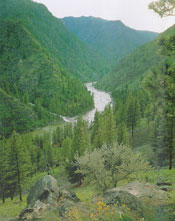
 |
| The Salmon River. |
The Salmon River drainage includes 14,100 square miles and flows 410 miles from its headwaters in Blaine County in south central Idaho to its confluence with the Snake River in Idaho County in northwestern Idaho. Upstream from the confluence of the Middle Fork, the Salmon River is lower gradient and it flows through open canyon and broad valleys. The portion from Horse Creek to North Fork is 50 miles long and is located entirely within Lemhi County. There is only a trail along the river from Horse Creek upstream to Corn Creek, and a road along the river for 46 miles from Corn Creek to the North Fork. Boats are the primary mode of access below Corn Creek.
The Salmon River is listed under the Wild and Scenic Rivers Act. From Vinegar Creek (near Riggins) to Corn Creek, the river is classified as "wild," and from Corn Creek to the North Fork, it is classified as "recreational."
Wild and natural steelhead migrate to this area in the early fall and overwinter prior to resuming their spawning migration in the spring. Since wild and hatchery stocks intermingle and wild stocks are consistently underescaped, harvest occurs on hatchery fish only (identified by adipose fin clips).
The Panther Creek drainage contains nearly 100 miles of streams and reportedly supported chinook runs of 2,000 spawners in addition to substantial runs of steelhead. Although habitat is in good condition, by the late 1960s, anadromous fish runs had declined due to poor water quality as a result of mine effluents. Little or no salmon or steelhead currently use Panther Creek for spawning or rearing. There are continuing efforts by the State of Idaho to secure funds to improve the water quality in this drainage.
The North Fork drainage contains about 60 miles of stream, some of which has been impacted by a variety of land-use activities such as mining and logging. It currently supports chinook and steelhead spawning and rearing. Other smaller tributaries to the main Salmon, such as Indian, Colson, and Pine creeks, primarily support steelhead spawning and rearing.
Small numbers of white sturgeon inhabit the river downstream from Horse Creek and may be present upstream. Limited habitat is available and, historically, sturgeon were present at least as far upstream as Salmon.
Westslope cutthroat trout emigrate from the Middle Fork Salmon River to overwinter in this portion of the Salmon River.